So, you’re excited about off the cuff prayer and scripted prayer, but how to get going? Here are a few proven helps in prayer to try out, both scripted prayers, and some model prayers to guide your praying well.
Some scripted prayer
First, as with most areas of knowledge, the internet has opened up immense archives of scripted prayers to peruse. Probably too many. I’ll point you to two that I have used with profit:
- A little book called The Valley of Vision (ask me about it, if you would like to check it out)
- The prayers of the Daily Office in The Book of Common Prayer (this link will take you to the prayers and readings for each day, called “The Daily Office”). Check out an app which brings it right to your phone: Daily Prayer.
These are both helpful sources of model prayers. I’m sure there are tons more out there, but I know these are good.
Scripted prayers can be helpful in expanding your understanding of what to pray for or how to pray. Let’s turn our attention now to prayer models which allow you to take advantage of the strengths of both off the cuff and scripted prayer.
On using prayer models
There’s a saying in academia that goes like this, “All models are wrong; some models are useful.” The saying refers to models like what weather forecasters use. They are tools we use to make sense of complicated data or experiences. While we like to roast weather forecasters, the reality is that we often rely a great deal on the ability of weather models to predict likely weather outcomes. I make my plans for tomorrow based on the weather forecast given today. And they do a pretty good job much of the time. We use them because they are useful. Not because they are perfect.
Model prayers have a similar function. The three model prayers I will share in brief provide a way to guide prayer time. To keep it focused. To direct our priorities in prayer to places that we can often overlook. Model prayer are a pattern to follow much like signs along a hiking trail—they keep you moving along in the right direction.
Here are three patterns to follow: the Lord’s Prayer, ACTS, and the praying hand.
the Lord’s Prayer
When Jesus’ disciples asked him how to pray, his response was a prayer. We call that prayer “The Lord’s Prayer” today. It can be found in Matthew 6:9-13 (the most famous version) or Luke 11:2-4 (the less famous but still good version). Prayer practices in Jesus’ day often involved repeating set prayers. That was very likely what the disciples were asking Jesus about: what is the set prayer your followers should pray? As such, we do well to still repeat this prayer today.
But the prayer also works as a framework. We can organize our own approach to God around the key themes which Jesus included in the model prayer he gives his followers.
Take each of the sections of the Lord’s Prayer to guide areas of life that require focus in prayer:
- Dear Father, you are _____
- Your kingdom come, your will be done in _____
- Give us _____
- Forgive us for _____
- and help us to forgive _____
- Protect us from temptation and evil in _____
It doesn’t cover everything worth praying for, but it guides our thoughts and feelings through an organized set of priorities worthy of prayer.
ACTS
Another well-known pattern prayer, the acronym ACTS, leads through key parts of our spiritual life before God:
- Adoration (spend time worshiping God) – Wow God, you are…
- Confession (repent of sins and ask for forgiveness) – I’m sorry for…
- Thanksgiving (thank God for what He has done) – Thank you for…
- Supplication (asking for help) – Please help…
This pattern is especially helpful in reminding you to spend time adoring/praising God and confessing sins, not just saying, “Here is what I want to happen.”
the praying hand
The praying hand, our final model, is one that I only learned about recently. But I have come to find in it a dear friend. Use your fingers to remind you of key areas that deserve prayer:
- Thumb: pray for those who are closest to you (the thumb is closest)
- Index/pointer: pray for those who teach and heal you (this finger is used for teaching)
- Middle: Pray for those who lead (this finger is tallest)
- Ring: Pray for those who are weak/sick (this finger is the weakest)
- Pinky: Pray for your own needs
A particular strength of this pattern is that it combats self-only focused prayers. We work through the needs of others in prayer before getting to our own. That is a beautiful practice of loving neighbor as self.
Follow the pattern prayers
Models work because they are simple, memorable, and effective. These three model prayers (there are many more) fit the bill. Use them well.

